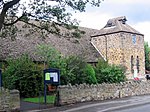Pilsley is a rural village and civil parish in North East Derbyshire, near Chesterfield. At the 2011 Census the population was 3,487. Pilsley consists of two distinct residential areas known as Lower Pilsley and Pilsley (sometimes Upper Pilsley). Lower Pilsley being the northern residential area and Pilsley being the southern residential area. There is some local disagreement as to whether these two areas constitute two separate villages or one larger village. At the start of the village's life, people referred to the area around what is now Pilsley primary as Nether Pilsley. Both areas of the village are united by the same parish council, Pilsley Parish Council, which was formed on 30 January 1874; Pilsley having previously been part of the parish of North Wingfield. Maps show that the village is made up of four separate residential areas, which are, in order of their north to south alignment, Lower Pilsley, Upper Pilsley, Pilsley and Nether Pilsley.Pilsley has an Anglican church, St Mary's, an evangelical Methodist church, two primary schools, a post office and a Kingdom Hall building for Jehovah's Witnesses. Pilsley also has a Village Hall and St Mary's Centre (formerly the church hall). Recently a new sports centre (The Elm Centre) was built for the school which is also available for community use. A section of the Midland Main Line (Nottingham to Chesterfield section) runs along the western edge of the village. A branch of the Great Central Railway ran through the village prior to the Beeching cuts of the 1960s, with a station sited on Station Road. The route of this former railway line now serves as a popular walking, cycling and horse riding trail known as the Five Pits Trail, linking Pilsley to Tibshelf, Holmewood, Grassmoor and beyond.
Pilsley has a Sunday league football team called Pilsley Miners Welfare Football Club. The team is currently part of the Chesterfield and District Sunday League.
There is also a cricket team which play on the welfare, made famous by Jason Clayton, there is even a end of the pitch called “the Clayton end” from which the star bowls from.
The source of the River Rother is at Pilsley.
Although it is not possible to see Chesterfield from the residential part of upper Pilsley, the famous twisted spire of the Church of St Mary and All Saints in Chesterfield can be seen from part of Locko Road (near the junction with Dale View Road) in Lower Pilsley, and from two specific places in the Pilsley area. Locko plantation (planted 1976) has a 15m wide strip without trees on the side facing Green Lane, this has been left clear to provide a view of the Chesterfield spire; however, it can only be seen from the top 20m of the plantation; it is most easily seen at night when the spire is floodlit. The second place where the spire can be seen is on the Five Pits Trail, about 300m north of the Timber Lane car park; the spire can be seen along an 18m length of the path through a gap between a row of houses in the Highfields area of North Wingfield.










